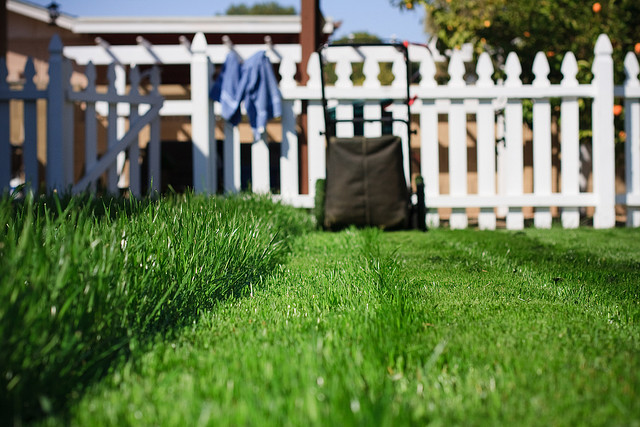
Spring is descending on the United States. Buds on trees and shrubs are swelling, and brittle brown grass is beginning to show green signs of life. As people put away their snow shovels and dust off their lawn mowers, it’s also a good time to take stock of the American lawn, which plays a starring role in the American dream. Backyard barbecues or weekend touch football games wouldn’t be the same without them, and there is something pleasing about a house perched amidst a nice green carpet. But grass is also a fussy plant, needing to be watered, fertilized, weeded, and, of course, mowed. For many, lawns are an American nightmare, yet we love them anyway.
Some Americans like to say they bleed red, white, and blue, but many should probably add green to that list, such is their devotion to their lawns. I myself am intimately acquainted with lawns and have been for many years. I started mowing my parents’ lawn as soon as I could safely see over the mower’s handle and took on a handful of my neighbors’ shortly thereafter. It didn’t take long until I was a lawn mowing connoisseur, changing the cutting pattern with every mow to give the yard a bit of golf course confidence. Even in college I couldn’t escape lawns. One of my summer jobs involved navigating a Toro Groundsmaster 322-D across school yards for eight hours a day. Even today, I still like the smell of freshly cut grass.
Our attachment to lawns means they have moved with us, even to climates where no lawn has any right to grow. Given how large they figure in the American subconscious, just how big is the collective American lawn? Nearly 50,000 square miles. That’s three times more than the area of irrigated corn in the U.S. And we grow a lot of corn. We’re still rolling out the green carpet, too. Between 1978 and 2001, we added between 170 and 355 square miles of lawn each year (depending on how you estimate it).
Much of that growth has come from the expanding suburbs. Lawns aren’t necessarily bigger than they used to be—in fact, median lot sizes have decreased while houses have continued to grow.¹ Part of the reason is that two story houses are more popular than before. Whereas only 23 percent of homes built in 1973 were had two stories, 53 percent do today.² So while houses have increased in size, lawns have kept pace, if only because they’ve reclaimed some of the built footprint.
More land under the seed-water-fertilize-mow regimen means more chemical applications, too. And given the intensity with which we dose our lawns, that should concern us. About 71 million pounds of active ingredients of herbicides, insecticides, fungicides, and other chemicals are dumped on U.S. lawns each year, or about 7 percent of all pesticides used in the U.S. Lawns may be attractive greenery, but they’re anything but green.
That’s not to say we should do away with lawns entirely. No way. But perhaps we could all do a little better by following two maxims my dad has for his lawn. First, he reasons that more fertilizer means more mowing. He applies it like a diabetic sugars his coffee—sparingly. It’s just enough to prevent our yard from becoming a neighborhood disgrace, but it’s a savvy approach. Some of our old neighbors fertilized religiously and therefore mowed religiously. The second mantra speaks to lawn size. “If the lawn takes longer than half an hour to mow, then it’s too big,” he says. While the half-hour rule was never entirely accurate—I paid close attention to how long I spent behind the mower—it’s the idea that matters. Our back yard was wreathed in butternut trees, general shrubbery, a small pond, and an honest-to-goodness prairie, all there, in part, to cut down on the amount of grass we had to maintain. Some people might balk at giving up that much turf, but I can assure you, it was still enough for a weekend game of football with my friends.
Sources:
Fishel, Frederick M. 2011. Pesticide Use Trends in the U. S. : Pesticides for Home and Garden Uses. PI-140. University of Florida Institute of Food and Agricultural Sciences Extension.
Grube, Arthur, David Donaldson, Timothy Kiely, and La Wu. 2011. Pesticides Industry Sales and Usage: 2006 and 2007 Market Estimates. U.S. Environmental Protection Agency.
Lindsey, Rebecca. 2005. Looking for lawns. NASA Earth Observatory.
Robbins, P. (2003). Turfgrass revolution: measuring the expansion of the American lawn Land Use Policy, 20 (2), 181-194 DOI: 10.1016/S0264-8377(03)00006-1
U.S. Census Bureau. 2010. Characteristics of New Housing.
Photo by seantoyer.
Related post: